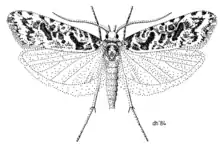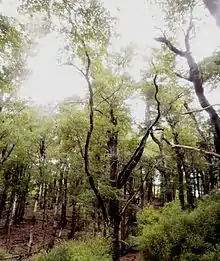Heterocrossa eriphylla
Heterocrossa eriphylla, also known as the lichen snoutlet moth, is a species of moth in the family Carposinidae. It is endemic to New Zealand. The larvae of this species feed on the healing wounds of New Zealand beech trees.
| Heterocrossa eriphylla | |
|---|---|
 | |
| Heterocrossa eriphylla illustrated by Des Helmore | |
| Scientific classification | |
| Kingdom: | |
| Phylum: | |
| Class: | |
| Order: | |
| Family: | |
| Genus: | |
| Species: | H. eriphylla |
| Binomial name | |
| Heterocrossa eriphylla | |
| Synonyms[2] | |
| |
Taxonomy
This species was described by Edward Meyrick in 1888 using a specimen he collected in Wellington in January.[2][3] In 1922 Meyrick classified Heterocrossa as a synonym of the genus Carposina.[4][5] George Hudson discussed and illustrated this species in his 1928 publication The Butterflies and Moths of New Zealand.[6] In 1978 Elwood Zimmerman argued that the genus Heterocrassa should not be a synonym of Carposina as the genitalia of the species within the genus Heterocrassa are distinctive.[4] In 1988 John S. Dugdale assigned the species back to the genus Heterocrossa.[2] The holotype specimen is held at the Natural History Museum, London.[2]
Description
H. eriphylla was described by Meyrick as follows:
Male. — 26 mm. Head and thorax whitish-greenish, shoulders olive-greenish. Palpi whitish-greenish, apex of basal joint and a band before middle of second fuscous. Antennae greyish-ochreous, basal joint dilated, whitish-greenish. Abdomen pale whitish-ochreous. Legs dark fuscous, apex of joints whitish, posterior pair pale whitish-ochreous. Forewings elongate, posteriorly slightly dilated, costa gently arched, apex obtuse, hindmargin straight, oblique ; pale greenish, irregularly irrorated with white, especially towards hindmargin ; about eight small black spots on costa, from which proceed obscure olive-green inwardly oblique strigulae ; three inwardly oblique pairs of large tufts in disc, olive-green anteriorly, white posteriorly, margined above and below by small black spots, first near base, second at 1⁄3, third at 2⁄3 ; a short black streak on fold between second pair, crossed by a cloudy black mark margining them anteriorly ; a slender white sinuate longitudinal line in disc between second and third pairs, unevenly black-margined, crossed by three or four irregular fine white strigae ; a sub-terminal series of small fine irregular black marks, angulated in middle ; hindmargin irregularly dotted with black scales : cilia whitish, towards base sprinkled with greenish. Hindwings and cilia whitish.[3]
Distribution
This species is endemic to New Zealand.[7][1] This species is found in the North Island and northern parts of the South Island.[8] Specimens of this moth have been collected near the Wellington Botanic Gardens and at the Orongorongo Valley,[9][10] as well as near Woodville in hill country.[11] This moth has also been collected at Paroa.[12] H. eriphylla is regarded as being relatively uncommon.[8]
Biology and behaviour
The adult moths are on the wing in December to April,[9] May and June.[12] This moth is a night flier and is attracted to light.[8] During the day the adult moths rest on tree trunks where their variable lichen mimicking colouration assists with their camouflage.[8] W. P. Cohen stated that he collected his specimens during the day while they were at rest on the trunks of weeping-willows.[9] The larvae of this species feed on the callus tissue generated by their host trees as a result of damage caused by other insects.[8] The larvae are believed to facilitate the development of rot in beech trees by keeping wounds open to the air.[13] The species pupates at their feeding site.[8]
Host species

H. eriphylla lives in native forest habitat.[8] The larvae of this species feed on the wood of the beech trees Fuscospora fusca and Fuscospora truncata.[14]
References
- Gordon, Dennis P., ed. (2010). New Zealand inventory of biodiversity. Volume two. Kingdom animalia : chaetognatha, ecdysozoa, ichnofossils. Vol. 2. Christchurch, N.Z.: Canterbury University Press. p. 457. ISBN 9781877257933. OCLC 973607714.
- Dugdale, J. S. (1988). Lepidoptera – annotated catalogue, and keys to family-group taxa (PDF). Fauna of New Zealand. 14. pp. 1–269. ISBN 978-0477025188. Retrieved 12 June 2018.
- Meyrick, Edward (1888). "Notes on New Zealand Tortricina". Transactions and Proceedings of the New Zealand Institute. 20: 73–76 – via Biodiversity Heritage Library.
- Zimmerman, Elwood (1978). Insects of Hawaii. 9. Hawaii: University of Hawaii Press. p. 797. hdl:10125/7338. ISBN 9780824804879.
- Meyrick, Edward (1922). "Lepidoptera Heterocera Fam. Carposinidiae". Genera Insectorum. fasc.176–180: 1–235 – via Biodiversity Heritage Library.
- Hudson, G. V. (1928). The Butterflies and Moths of New Zealand. Wellington: Ferguson & Osborn Ltd. p. 217. OCLC 25449322.
- "Heterocrossa eriphylla Meyrick, 1888". www.nzor.org.nz. Landcare Research New Zealand Ltd. Retrieved 13 June 2018.
- Hoare, Robert (2014). Moths & Butterflies of New Zealand. New Zealand: New Holland Publishers (New Zealand) Ltd. p. 43. ISBN 9781869663995.
- Cohen, W. P. (1895). "Notes on rare Lepidoptera in Wellington". Transactions and Proceedings of the New Zealand Institute. 28: 377–379 – via Biodiversity Heritage Library.
- Dugdale, J. S. (January 1995). "A new genus and species of New Zealand Carposinidae (Lepidoptera)". New Zealand Journal of Zoology. 22 (2): 213–216. doi:10.1080/03014223.1995.9518036.
- McGregor, Peter G.; Watts, P. J.; Esson, M. J. (January 1987). "Light trap records from southern North Island hill country". New Zealand Entomologist. 10 (1): 104–121. CiteSeerX 10.1.1.694.3746. doi:10.1080/00779962.1987.9722515.
- Lyford, Brian M. (January 1994). "Lepidoptera and Trichoptera from Paroa, near Greymouth, New Zealand" (PDF). New Zealand Entomologist. 17 (1): 46–51. doi:10.1080/00779962.1994.9721984. Archived from the original (PDF) on 24 July 2011. Retrieved 13 June 2018.
- Blakely, Tanya J. (2008). "Tree holes as habitat for aquatic and terrestrial invertebrates" (PDF). www.ir.canterbury.ac.nz. Retrieved 12 June 2018.
- "PlantSynz – Invertebrate herbivore biodiversity assessment tool: Database". plant-synz.landcareresearch.co.nz. Retrieved 13 June 2018.
External links
| Wikimedia Commons has media related to Heterocrossa eriphylla. |
| Wikispecies has information related to Heterocrossa eriphylla. |